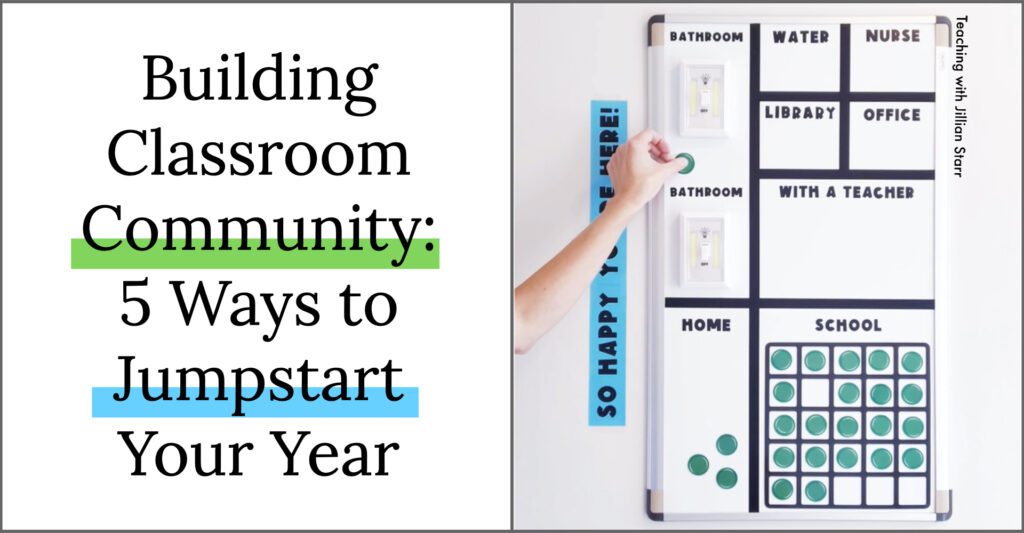
Jumping back into the school year means a million to-dos, one of the most important of which is planning how you will go about building a classroom community. Figuring out where to begin can be SO tricky!
Many of you have reached out this year, excited and nervous about the start of a more “normal” school year. But whether massive changes to school structure have thrown you off your back-to-school routine or you’re entering your very first classroom, it can be overwhelming. You might not even know what a typical back-to-school season looks like. Let alone what it requires ahead of time!
You’re in luck. Building a classroom community is one of my favorite parts of the job. I love thinking about how I can design a space, routine, and classroom to fit the needs of my new learners. But to be honest- it took me a few years and a lot of time to develop an efficient system that helped me complete the most critical to-dos of building a classroom community. As your virtual teammate, I’ve drafted this guide to jumpstart your year! I’ve thought of the FIVE most important areas on which to focus before the first day of school.
Organize
The school year gets busy quickly. You’ve got your hands full of all the excitement that comes with welcoming a new group of learners. That’s why I’ve got one BIG back-to-school piece of advice for you: ORGANIZE!
The moment I open my doors to students, I want to make sure that everything has its place. The organization of materials makes it so that everything from routines to centers can run smoothly.
Organizing classroom materials and supplies BEFORE the first day of school will help you start the school year off on the right foot. And, it will keep your classroom ready as you introduce your classroom to your students.
When planning and organizing the physical items of my classroom, I find it easiest to break them down into three categories:
- Classroom Supplies & Communal Materials
- Individual Student Supplies
- Individual Student Resources
Classroom Supplies & Communal Materials
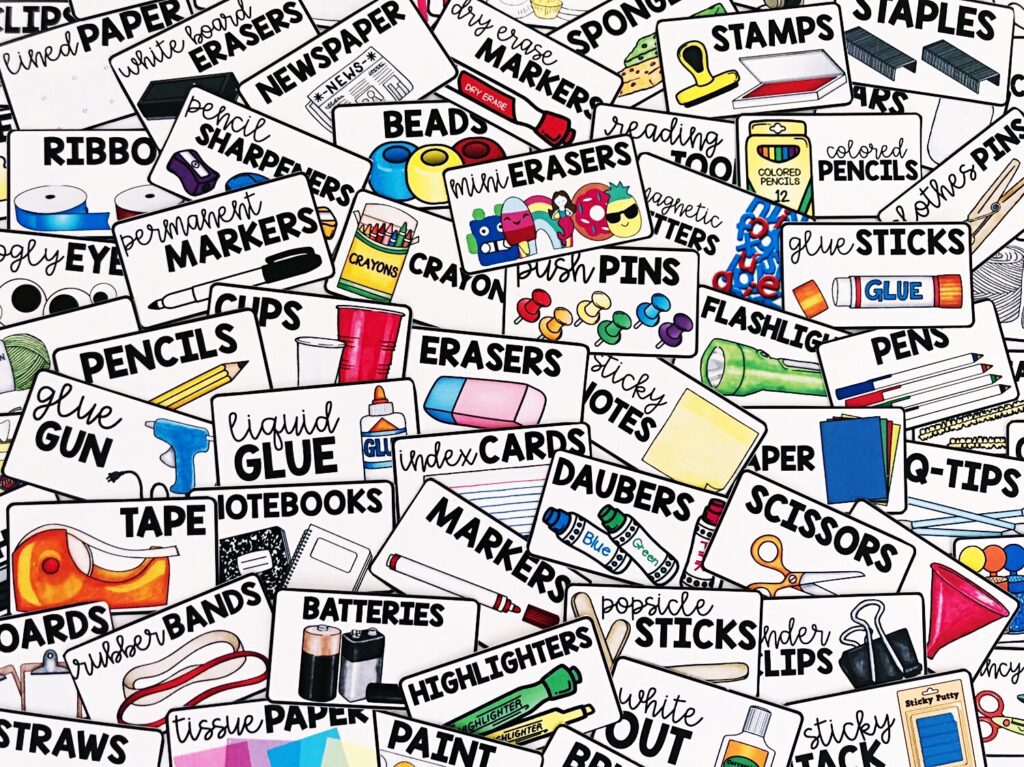
Communal supplies are items that we regularly use (sometimes even daily). But, we don’t need one for each student. It includes classroom supplies, such as loose-leaf paper and manipulatives.
I know these will get a lot of use all year long. So, students need them organized in a way they can access them independently.
Labeling is my secret to success. There is nothing more helpful than SEEING exactly where to look for something. Labels make all of my classroom supplies and manipulatives accessible to students.
I include simple, clear pictures with minimal text so students can find what they need quickly without worry. Even if I have a student who tends to forget precisely where to find an item, they tend to know the general location and they can rely on their peers for support. The label gives them instant information without having to open every drawer or search every cubby.
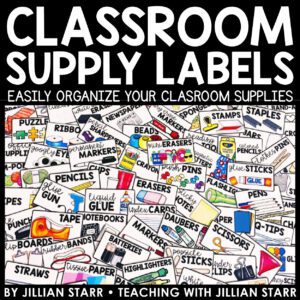
Classroom Supply Labels
Individual Student Supplies
Individual student supplies include the essentials for independent and partner work. They are supplies that each student should have at least one. Some examples include:
- Pencils
- Pens
- Markers
- Color pencils
- Glue sticks
Storage of Individual Supplies
Individual student supplies might be a bit of a misnomer. The first step is to decide whether or not you want students to have personal supplies or whether you want to create shared material routines. With COVID-19 restrictions, you might not have a choice this back-to-school season.
Shared essentials should also be carefully labeled and organized. I find that table caddies (think: shower caddies with a handle) are an amazing way to instill student independence without handing over too many materials. The handle makes them easy for a table manager (a student job) to grab and bring over to their crew. They also store a lot of materials with high walls. Nothing falls out!
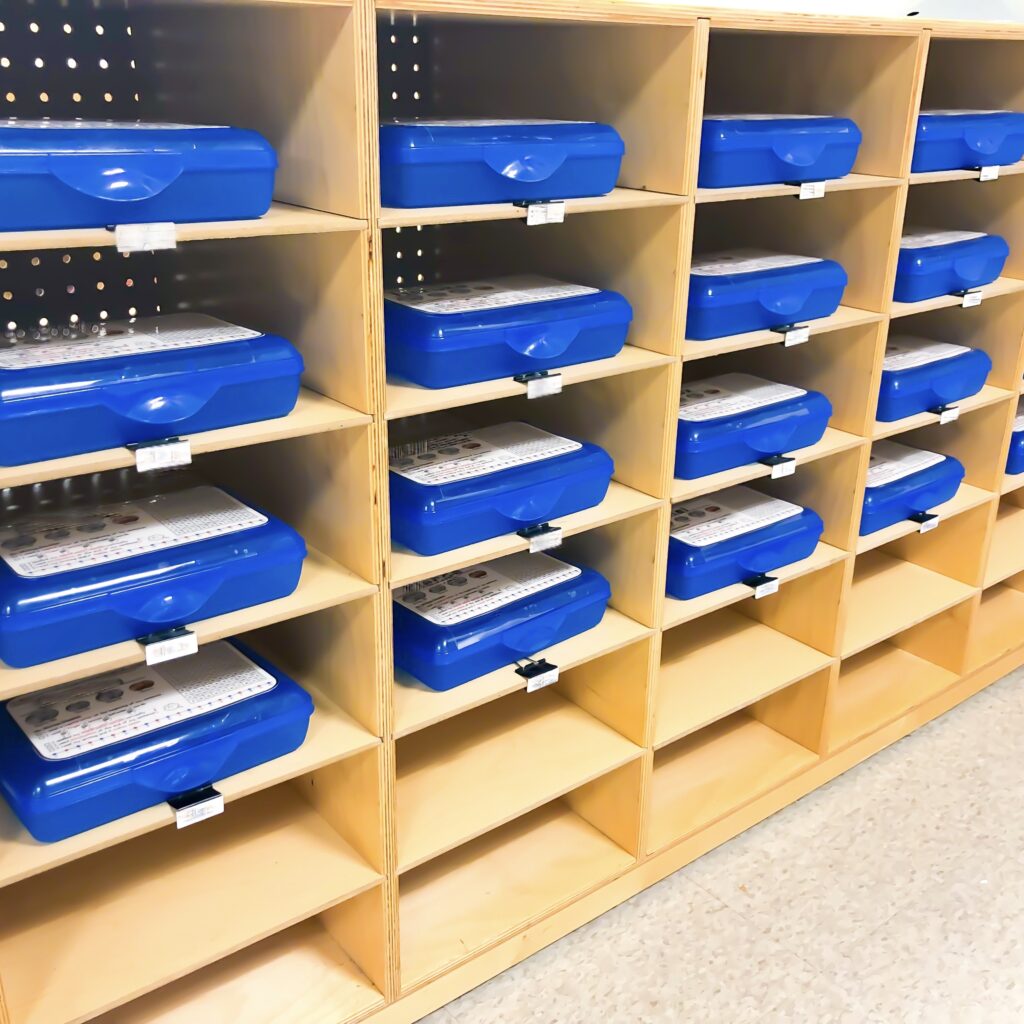
Here’s my preference. I find that my students thrive and become independent workers most efficiently when they have their own materials right at their fingertips. Enter: toolboxes! Small, plastic clasp boxes are my GO-TO for individual student supplies. Their name goes right on the top, and they fit every essential. These little clip boxes can often be found at the dollar store or in the back-to-school bins at Target.
Individual Student Resources
What resources will your students need to organize THEIR own work? In my classroom, I like to keep it simple. Students keep their work in three forms:
- Journals
- Folders
- Binders (when I taught third grade)
When the back-to-school email arrives, I get started planning what materials to buy and how to organize them by looking over my schedule. I make notes in each subject block, thinking about what routines and personal organizational systems might work best in the classroom. I will ask myself:
- What kinds of activities will students do?
- Will they have a lot of loose-leaf papers?
- Do I want them to do their work in a journal?
- Will there be a lot of partner work?
I decide which subjects need each of the above resources. Then, I label with names and color-code. COLOR-CODING is the best way to streamline student organization. It simplifies routines and gives students more independence.
When I say color-coding, I mean designate one color folder for a specific subject or routine. For example, social studies folders would be green, reading folders are red, and math folders are blue. This way, students instantly recognize the color and connect it with the subject, and clean up and reorganizing are a breeze!
Finally, I decide where to house student resources.
- Will all of the folders/journals/binders for one subject stay together? Create a bin for each.
- Will students have one place to find all of their resources? Create a bin or cubby dedicated to each student.
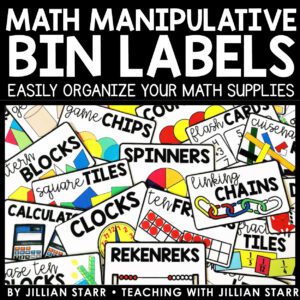
Math Manipulative Bin Labels
Know your routines!
Organizing and planning routines for your classroom go hand in hand! Planning routines is one of the most important steps in building classroom community that will set you up for success and independence all year long. Setting up your classroom with clear visual systems in place will get your brain thinking about using the space itself.
My aim with organization and routines is to give students the tools to be the most independent. I want them to take ownership over their classroom and their learning.
And trust me, to do that, planning out routines and procedures before the first day of school is a MUST.
How do I start? I look closely at my weekly schedule– block by block– and write out what routines we need to establish, practice, and perform throughout the year:
- During class time
- From subject to subject
- In and out of the classroom
Then, I envision my students using the space. I imagine what students will need, how you want students to retrieve their materials, and helpful structures to keep them engaged.
Transition routines are just as important. As I examine each block, I also think about moving from one subject to another. It helps to think of habits for when students start in one space and then go to another. Don’t reinvent the wheel! Think of transitional habits that are flexible.
Finally, I think about systems for entering and leaving the classroom. That includes:
- Bathroom procedures – How will students let me know their needs?
- Arrival & Dismissal – How will students enter and exit my classroom with ease each day?
- Transitions to specialists – How will students prepare themselves for another classroom with another teacher?
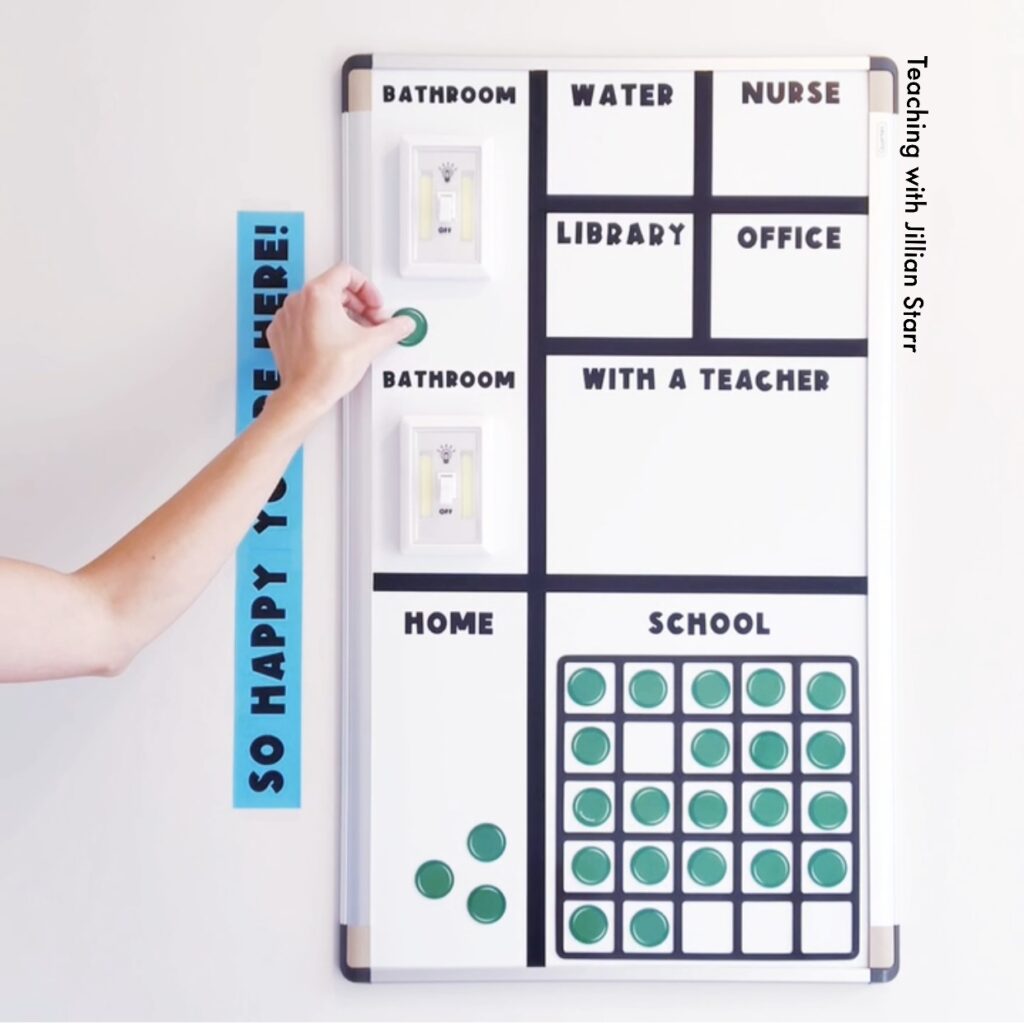
Slowly and deliberately introduce your routines. “Practice makes all the difference” is my motto. I come from Responsive Classroom schools. And if you’re not familiar, the first SIX weeks are school are focused on modeling, practicing, and reflecting on routines.
We break down, model, and practice each routine multiple times before students do them independently. When I first started, I skimped on modeling and practice, trying to dive right into the curriculum for the year. What did I repeatedly hear throughout the year? “Ms. Starr, where does this go?” and “What should I do?”
That ended when I took the time to practice. You will go further once your students feel confident in the structure and organization of your classroom.
Note: Your routines might change as you notice what your students look like in your classroom. That’s okay! Flexibility is a keystone of teaching. You can model being a flexible teammate by teaching a routine and then explicitly noticing that it needs an adjustment!
Co-Create the Rules
Your students have arrived. Now it’s time to develop classroom agreements. Yes, AFTER your students have entered your classroom. Students start to own their classroom when they get to be a part of its development. Co-creating rules ensures that needs feel HEARD, and students understand the reasoning behind our classroom rules/agreements. This is one of the cornerstones of building a classroom community in the early days of the school year.
Personal Goals
We start by setting personal goals, our “Hopes and Dreams.” These can be academic, friendship, classroom-community based.
Then, I have my students share our personal goals and brainstorm ways in which we can support each other. Since WHOLE community share can be intimidating, I like to form groups of two or three. They listen and record each other’s goals. Then, they think about ways they could help their teammate achieve those goals.
Sharing & Reflecting
Following this work, students share out their ways of supporting others with the group. You might notice that your list of ways to help one another starts to get LONG. That’s ok! It won’t be for long.
After building a long list of ideas, I scaffold a conversation to help students consolidate their brainstorm into 4-6 rules. I do this by asking students to think of big categories that each support can go into. You might ask, “Which supports go together?” I like to circle those connected supports in distinct colors. Then, rephrase what each category name might mean. Some examples might include:
- Respect the materials
- Respect the classroom space
- Support one another
- Try your best
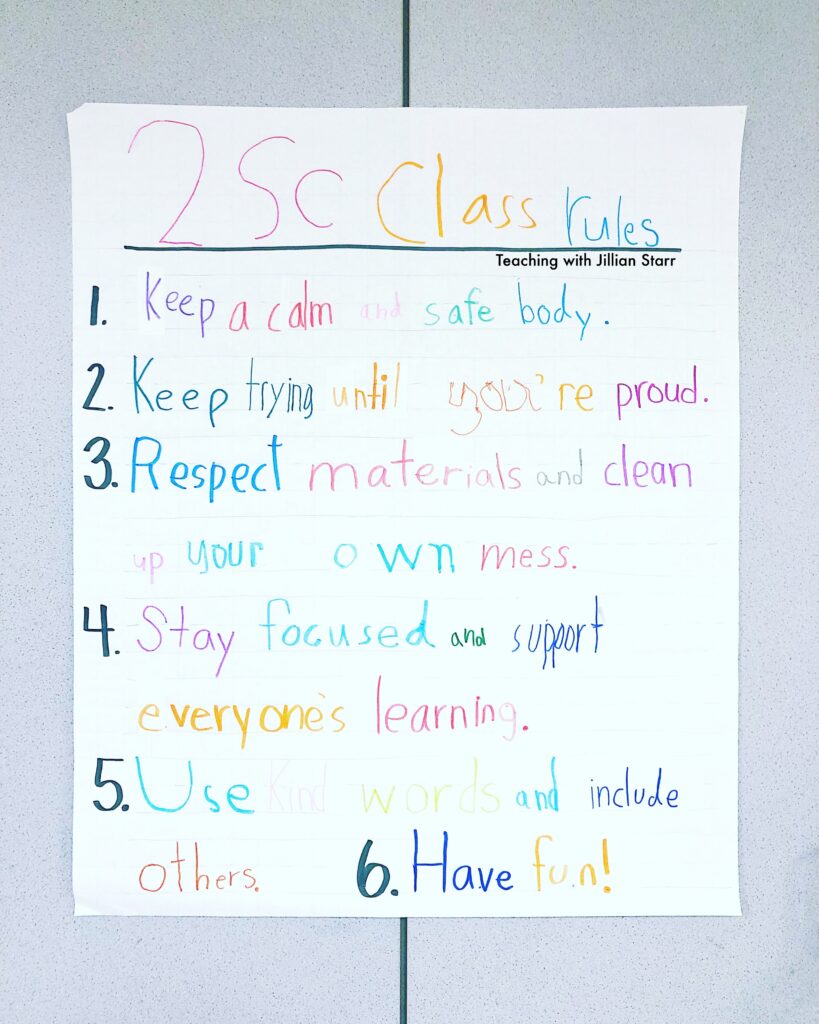
It is okay to let this process continue for a while! Let students debate about what feels most important, let them remember needs or supports over time, add, take away… let them grow their list of rules, so it feels authentic!
Finally, use your agreements! When I first started teaching, I would finish up our rules and put them up on the wall. Then, I would move on. It was okay, but the rules didn’t stick. I realized that if students rerecorded the rules themselves, then used them in an activity, they became a much more active part of our classroom.
Build Community
What’s an essential part of building a classroom community? Acknowledging your community members!
Numerous opportunities for students to share parts of themselves and create connections are vital. And you know I’ve got a few favorites that I make sure to work into our schedule every back-to-school season.
Friend Wanted Ads
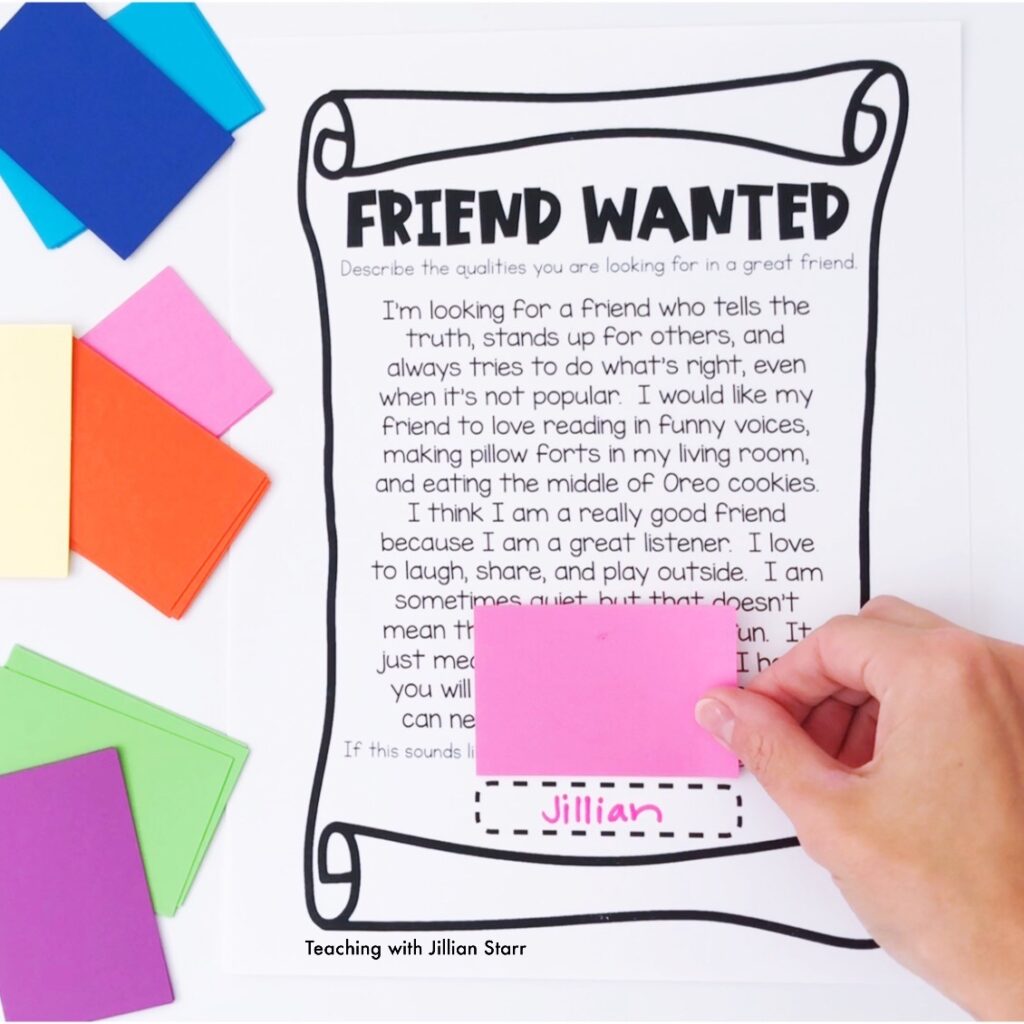
Friend Wanted signs are a yearly tradition. Whether students have deep connections, no connections, or trouble making connections, they all have a BLAST thinking about their ideal friend.
How to play: Students anonymously write about the qualities they most desire in a friend. They explain activities they would like a friend to enjoy and think about the qualities of a friend that help them trust and have fun with that person.
Helpful Tip: Post these with names covered (able to be flipped upwards to reveal them). Hang them where students can easily access them, periodically looking for new friendships. Additionally, stress that students should not include physical qualities.
“Friend Finder” Scavenger Hunt
Another class favorite for building back-to-school connections: A Classmate Scavenger Hunt! It is a fantastic way to break the ice, get kids moving, and encourage students to ask questions about each other. I like to use this activity on the first day of school since it is less structured, involves little supplies, and is low stakes.
How to play: Students receive a sheet of paper with about eight prompts to spark conversation. They have to move around the room and ask questions to find friends who have engaged in certain activities throughout the summer.
“Getting to Know Each Other” Venn Diagram
The “Getting to Know Each Other” Venn diagram is a significant next step for students to learn about each other. It helps students start identifying how they are similar and different from each other.
How to play: Like all Venn diagrams, there are two intersecting circles on a sheet of paper. On one side, it says, “Only Me.” The other says, “Only my partner.” In the middle, there is a label for “this is what we have in common.” Each student receives their own sheet of paper, a clipboard, and a pencil. Then, once partnered up, the students have to ask each other questions that lead to likes, dislikes, ways they identify, and ways they see themselves.
Helpful Tip: Model sample questions ahead of time. Some students may have difficulty knowing what type of question to ask. A sheet of questions can help really stuck partners.
Plan your read alouds
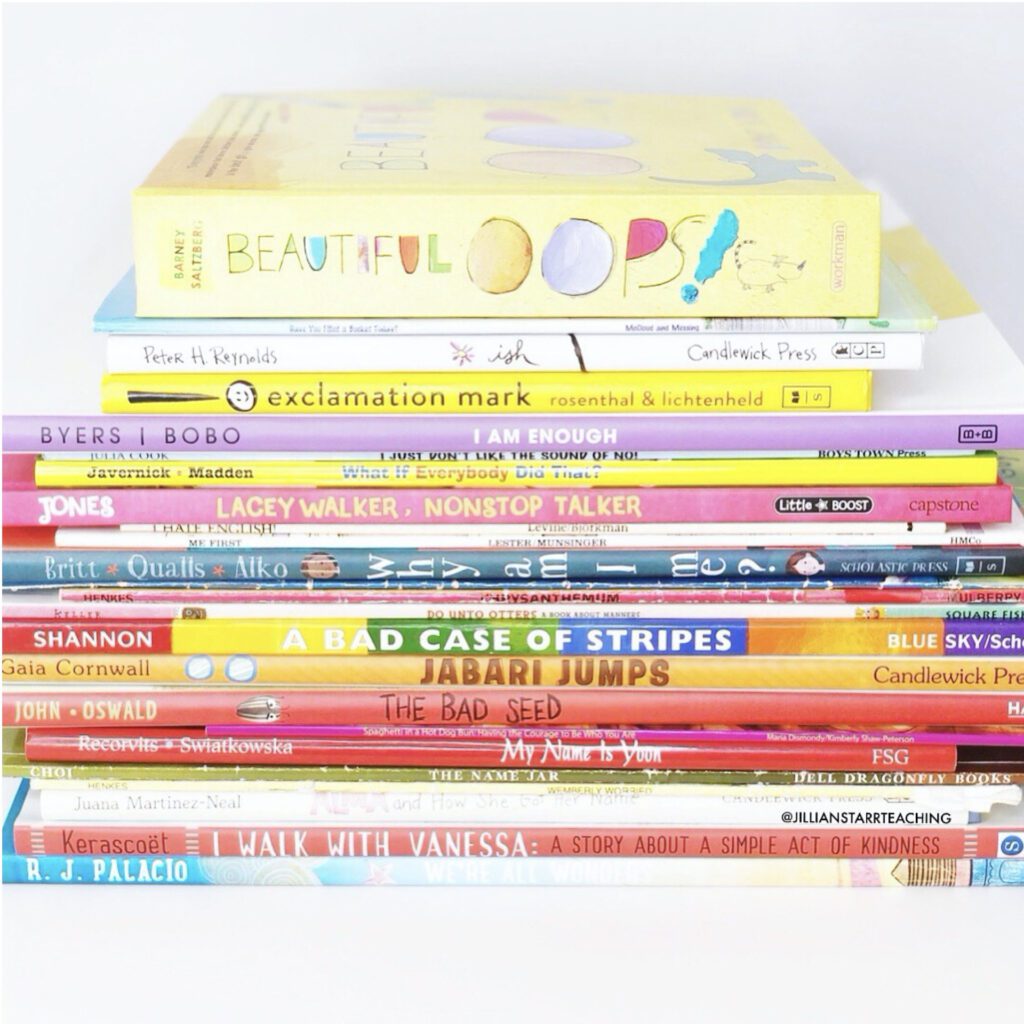
I’ve said it before, and I’ll repeat it: your back-to-school read alouds set the tone for building your classroom community. I want my students to know that I welcome and value them. So, I find read-alouds to reinforce those hopes. There are four main themes I look for in read alouds. Below I’ve picked one of many books for each theme to get you started:
Validate Feelings
Students need to feel emotionally supported to bring their best selves to the classroom. Back-to-school jitters are a familiar feeling you can address ASAP.
Wemberly Worried is a classic book for acknowledging how overwhelming the first day of school can be. It validates the feeling of being worried and provides very relatable worries for your students. Wemberly worries about EVERYTHING. And the exaggeration helps kids to identify playfully.
Honor + Affirm Identities
Read alouds are a fantastic way to get started honoring and affirming identities. They are a cornerstone in your inclusive classroom foundation.
The Day You Begin is the first book I read with this focus in mind. Woodson shows that everyone’s experiences are valuable, no matter what. She encourages readers to start sharing themselves with their community. The day you begin to show the world your true self is the day others can value you.
Establish + Reinforce Classroom Expectations
Young learners love to feel knowledgeable. I’ve found that connecting classroom expectations to read-alouds get them excited to discuss why certain expectations exist.
If Everybody Did is a fantastic book that reaches all students who push back against the classroom rules. It explains why a strong community depends on everyone following the rules. And don’t worry, there is plenty of humor to keep the group full of smiles!
Build Community
I Am Human is a must-read book for building a classroom community that is centered in empathy. It emphasizes that we all make mistakes, we all do things we regret, and we are all good people regardless of those poor choices we might make. Your next choice is a fresh start! It sends a powerful message to students who may feel outcasted due to poor choices in the past. This story lets them know that they will have many opportunities to try again this year!
I wish you a fantastic back-to-school season! I hope these strategies help you get ready to begin building a classroom community and feel prepared for all of the excitement, twists, and turns of a new year. Keep me posted!

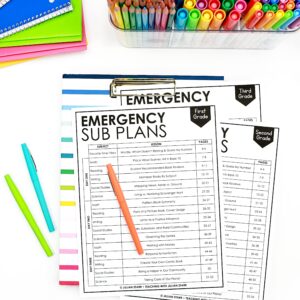

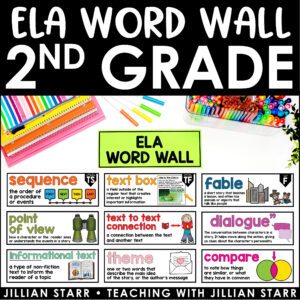
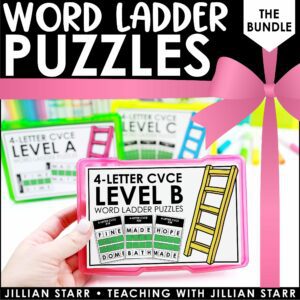
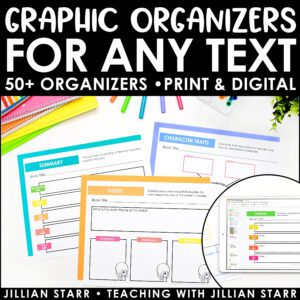
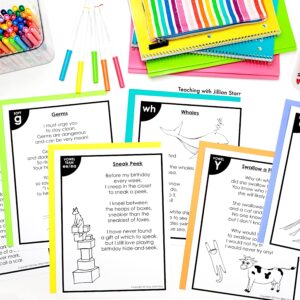
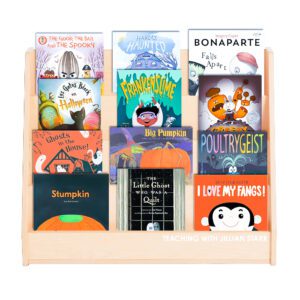
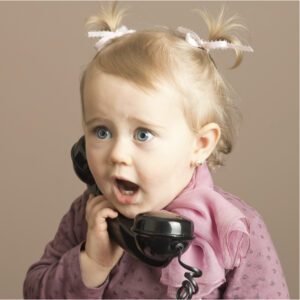


My kids lose their ever-loving minds when I read If Everybody Did. Such a silly book! I especially love the flattened cat and dad’s feet. Those two illustrations are ridiculous. As always, love your suggestions, Jillian!!!